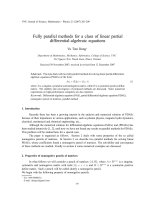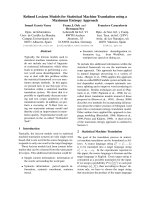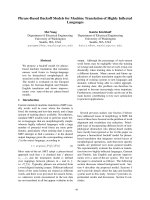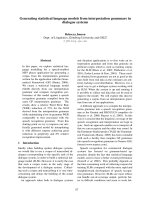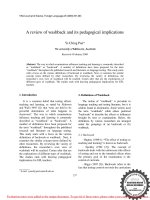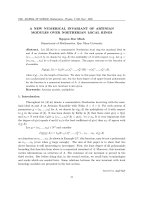Báo cáo "A process of building 3D models from images " pptx
Bạn đang xem bản rút gọn của tài liệu. Xem và tải ngay bản đầy đủ của tài liệu tại đây (283.4 KB, 6 trang )
VNU Journal of Science, Mathematics - Physics 23 (2007) 9-14
9
A process of building 3D models from images
Bui The Duy, Ma Thi Chau
*
College of Technology, VNU
144 Xuan Thuy, Cau Giay, Hanoi, Vietnam
Received 9 July 2007; received in revised form 5 September 2007
Abstract. Recently, a number of new technologies to capture 3D data have been developed. The
application potential of 3D models is enormous, such as, in education, entertainment, medicine,
etc. In this paper, we present our work toward creating 3D model of free form objects from pair of
images. We use the basic process of building 3D models proposed in Multiple View Geometry in
computer vision by Richard Hartley and Andrew Zisserman which includes three main phases:
Preprocessing, Matching, Depth Recovery.
1.
Introduction
Nowadays, 3D model building is getting more and more attention from the research community.
The rising attention is partly because of the technique’s promising applications in such areas as
architectural design, game produce, movie-postprocessing and so on. In order to have 3D models, the
traditions are normally used, in which technicians use specialized equipments to get 3D information.
The method costs a lot of expenses. In other approach, technicians use prior knowledge of objects to
build the objects’ 3D models manually and then apply the texture on these models. However, the
methods require enormous manual effort. On the other hand, 3D models’ qualities do not really meet
the demand of reality, because subjective factors can affect the result. Recently, many researchers have
†
been trying to find out robust as well as efficient methods to reconstruct 3D models. A new approach
is investigated to reduce the human effort is to build 3D models automatically from images [1].
In this paper, we introduce our work of creating 3D model automatically from pair of images.
Among many proposed methods we chose the framework proposed in [1] because of its completeness
and practicality. The primary process described in [1] includes three main phases: Preprocessing,
Matching, Depth Recovery. By combining and testing lots of related techniques and algorithms, we have
introduced an effectively completed process which uses two images of an object as input and then
automatically makes out the object’s 3D model as output. The whole process consists of six steps in
details: SUSAN corner extraction, SUSAN corner matching, F matrix computing, Polar rectification,
dense matching, and triangulation and texturing. The approach is a promising feasible solution.
Section 2 gives an overview of the 3D model reconstruction and relevant techniques. We then
propose our process by associating selected techniques in Section 3. We then show the experiments
that we have done in Section 4.
______
*
Corresponding author. Tel: 84-4-7547812
E-mail:
Bui The Duy, Ma Thi Chau / VNU Journal of Science, Mathematics - Physics 23 (2007) 9-14
10
2.
The 3D reconstruction process
The basic principle used in reconstructing 3D information is triangulation one [2]. In most
techniques, a triangle is created between the object and two sensors. So, constructing 3D information
needs at least two slightly different 2D images.
We follow the 3D reconstruction process introduced in [2], which is illustrated in Figure 1. The
process consists of three main phases: Preprocessing, Matching, Depth Recovery. These steps will
now be discussed in more details.
Figure 1. Main tasks of 3D reconstruction.
2.1. Preprocessing
The first step involves in relating two different images. In order to determine the geometric
relationship between images, it requires number of corresponding feature points. Feature points are
strongly different from its neighbors in the image so it can be matched uniquely with a corresponding
point in another image. There are many kinds of feature points and methods of feature extraction
published [3]. These corresponding feature points are then used to determine the geometry constraints
between two images, which are mathematically expressed by the fundamental matrix.
2.2. Matching
At this step, input images are rectified according to the fundamental matrix computed by first step.
Among the 3 main steps of the 3D reconstruction the matching step is extremely important. The above
feature matching is only spare matching. But we need all image points are matched for having a real
model. Image pairs are rectified so that epipolar lines coinciding with the image scan lines which
reduces the correspondence search to a matching of the image points along each image scan-line. In
rectification, pair of images is re-sampled so as to make imposing the two view geometry constraints
simple. As a result, most image points in the first images are corresponding to image points in the
second one.
2.3. Depth recovery
At this stage, by dense disparity matching determined in the second step, 3D information of all
image points is computed. Triangulation principle and optimal triangulation method [2] are used to
Two images
3D model
Pre
-
processing
Matching
Depth Recovery
Bui The Duy, Ma Thi Chau / VNU Journal of Science, Mathematics - Physics 23 (2007) 9-14
11
estimates the depth of all image points or raw 3D model. After that, one of original images is used to
texture the raw model to have final 3D model.
3.
A proposed process
In this section we motivate and present our completed process of 3D model building and its
relation to others. The whole process is shown in figure 2.
Figure 2. A process of 3D reconstruction.
3.1. SUSAN corner extraction
Feature can be classified as feature area, feature line or feature point. SUSAN (Smallest Univalue
Segment Assimilating Nucleus) corners are feature points which are easily computed and effective in
matching. To extract Susan corners, we use a circular mask. Its center is called nucleus. USAN
(Univalue Segment Assimilating Nucleus) area is defined as an area including interested pixels which
have the same brightness as nucleus’s brightness. The shape of USAN areas conveys important
information about the structure of the image in the region around the nucleus [4]. An algorithm
proposed in [4] uses the information by comparing the brightness difference between the nucleus and
its neighbors (pixels within the same circular mask) to extract SUSAN corners.
3.2. SUSAN corner matching
Given a point c
1
(u
1
,v
1
) (a SUSAN corner found in 3.1) in the first image, we use a correlation
window of size (2n+1) × (2m+1), centered at this point. We then select a rectangular search area of
size (2d
u
+1)x(2d
v
+1) around this point in the second image (called c
2
(u
2
,v
2
)), and perform a correlation
operation on a given window between c
1
and c
2
lying within the search area in the second image. The
correlation score, S(c
1
,c
2
), is defined as:
(
)
( ) ( ) ( ) ( )
( )( )
(
)
(
)
1 1 1 1 1 1 2 2 2 2 2 2
1 2
2 2
1 2
2 1 2 1 σ σ
n m
i n j m
I u i,v j I u ,v I u i,v j I u ,v
S c ,c
n m I I
=− =−
+ + − × + + −
=
+ + ×
∑ ∑
SUSAN corner
matching
F matrix
computing
Polar
rectification
SUSAN
corners
Dense
matching
Two
images
3D model
Triangulation
and texturing
Bui The Duy, Ma Thi Chau / VNU Journal of Science, Mathematics - Physics 23 (2007) 9-14
12
where as,
( ) ( )
( )( )
2 1 2 1
n m
k k
i n j m
I u,v I u i,v j / n m
=− =−
= + + + +
∑ ∑
,
k=1,2.
(
)
k
I
σ
is the standard deviation of the image I
k
in the neighbourhood (2n+1) × (2m+1) of (u,v), which is
given by:
( )
( )
( )( )
( )
2
2 1 2 1
n m
k
i n j m
k k
I u,v
I I u,v
n m
=− =−
σ = −
+ +
∑ ∑
The score ranges from 1 down to -1 for two correlation windows which are similar or not. A
constraint on the correlation score is then applied in order to select the most consistent matches: for a
given pair of points to be considered as a candidate match, the correlation score must be higher than a
given threshold. For each point in the first image, we thus have a set of candidate matches from the
second one and vice versa. So we use some techniques known as relaxation techniques [5, 6] to
resolve the matching ambiguities. The idea is to allow the candidate matches to reorganize themselves
by propagating some constraints, such as continuity and uniqueness, through the neighborhood.
3.3. Fundamental matrix
Fundamental matrix 3 × 3 F expresses mathematically the geometry constraints between two
images. Hartley [2] has pointed out RANSAC algorithm, a simple method, to compute F matrix. This
matrix can be found by solving 8 linear equations. So, N samples of feature matching couples are used
not only to compute F matrix but also to refine it.
3.4. Polar rectification
Rectification is an important step aim to save time and cost in matching by reducing the size of
search area. Polar rectification transforms input images from Deccacter co-ordinate (x,y) into polar co-
ordinate (r,θ) [7] (figure 3). We use rectified images as input of matching step. As a result of
rectification, in matching, instead of searching corresponding point in the whole second image, we
only search it in a specific scanline.
Figure 3. Co-ordinate transformation.
3.5. Dense matching
Each pixel (x,y) in the first image we put a correlation window such as (x,y) is the position of
window’s center. We find out (x’,y’) matching with (x,y) by changing another window on scanline of
Bui The Duy, Ma Thi Chau / VNU Journal of Science, Mathematics - Physics 23 (2007) 9-14
13
(x,y) in the second image. Disparity of the two window determine if (x,y) and (x’,y’) are matching pair.
The disparity is calculated by SAD (Sum of Absolute Differences) as follow:
( )
(
)
(
)
( )
( )
1 2
2
2
1 2
' '
i,j
' '
i,j i,j
I x i,y j I x d i,y j
c x,y,d
I x i,y j I x d i,y j
+ + − + + +
=
+ + × + + +
∑
∑ ∑
where as I
k
is the mean of the k
th
window’s grey intensities.
Nishihara [8] has suggested some correlation window’s sizes to increase matching accuracy.
3.6. Triangulation and texturing
For each 3D to 2D correspondence (X, x), we have projection equation x = PX, where as x and x’
are image points. X is related point in 3-space. P and P’ are camera matrices [2]. AX = 0 is a result of
combining the two equations. Singular Value Decomposition [2] is an effective way to compute X.
Fortunately, between (P, P’) and fundamental matrix has a great constraint [2] we can easily
compute one from other and in turn. We can have unique F matrix from P and P’. However, pair of P
and P’ is not unique one from a specific matrix F. We choose P and P’ as follow
P= [I|0] and P’= [[e’]
x
F + e’v
T
|λe’]
where as v is a three-dimension vector and λ is a non-zero constant.
In reality there are many matching points between the two images. Therefore, it was necessary to
compute an algorithm that is going to choose a corresponding point from the second image with the
highest confident level.
4.
Experiments and discussion
In this section we give the results of our technique on synthetic and real data. The synthetic
experiment setup is based on some related work. We have two input images (figure 4 a, b). Figure 4c
shows Susan corners computed get from two original images. Pair of rectified images are presented in
Figure 5a, b, and figure 5c is the picture of the 3D resultant model.
a, b, c,
Figure 4. a,b Two original 480x640 images; c, Susan corners.
Bui The Duy, Ma Thi Chau / VNU Journal of Science, Mathematics - Physics 23 (2007) 9-14
14
a, b, c,
Figure 5. a,b Pair of rectified images; c, 3D resultant model.
The process involved to two input images. Two images suitable for the initialization process are
selected so that they are not too close to each other on the one hand and there are sufficient features
matched between these two images on the other hand. However, there are still some inexact areas in
the 3D model because of occlusion and the simplicity of the used algorithms [6, 9]. The result can be
refined each time a new view (image) is added. In future, to improve the quality we will try to use
more sophisticated algorithms as well as increase the amount of images.
5.
Conclusion
We presented in this paper our work toward the creating of a 3D model from two images. Using a
building process in thee steps, we have generated a 3D model of a free-from view with a fair overall
quality. In the future we want to improve the reconstruction process more in order to have a more
detailed and accurate 3D model.
References
[1] R. Sablatnig, M. Kampel, Computing relative disparity maps from stereo images, ERASMUS Intensive Program,
Pavia, Italy, 2001.
[2] R. Hartley, A. Zisserman, Multiple View Geometry in computer vision, Cambridge University press, 2000.
[3] C. Harris, M. Stephens, A combined corner and edge detector, Fourth Alvey Vision Conference (1988) 147.
[4] S.M. Smith, J.M. Brady, SUSAN - a new approach to low level image processing, Springer Netherlands, 2004.
[5] Oliver Faugeras Bernard, Real time correlation-based stereo: algorithm, implementation and application.
Technical Report 2013, INRIA, Institut National de Recherche en Informatique et en Automatique, 1993.
[6] T. Kanade, M. Okutomi, A Stereo Matching Algorithm with an adaptive window: Theory and Experiment,
Pattern Analysis and Machine Intelligence, IEEE Transactions 16, 1994.
[7] R.I. Hartley, Theory and practice of projective rectification, Technical Report 2538, INRIA, Institut National de
Recherche en Informatique et en Automatique, 1995.
[8] H.K. Nishihara. PRISM, A Practical Real-Time Imaging Stereo matcher, Technical Report A.I. Memo 780, MIT,
Cambridge, MA, 1984.
[9] U.R. Dhond, J.K. Aggarwal, “Structure from Stereo – A Review”, IEEE Tran. Man and Cybernetics 19 (1989) 1489.

